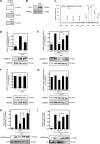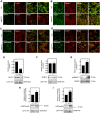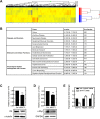Myosin phosphatase and RhoA-activated kinase modulate arginine methylation by the regulation of protein arginine methyltransferase 5 in hepatocellular carcinoma cells
- PMID: 28074910
- PMCID: PMC5225440
- DOI: 10.1038/srep40590
Myosin phosphatase and RhoA-activated kinase modulate arginine methylation by the regulation of protein arginine methyltransferase 5 in hepatocellular carcinoma cells
Abstract
Myosin phosphatase (MP) holoenzyme is a protein phosphatase-1 (PP1) type Ser/Thr specific enzyme that consists of a PP1 catalytic (PP1c) and a myosin phosphatase target subunit-1 (MYPT1). MYPT1 is an ubiquitously expressed isoform and it targets PP1c to its substrates. We identified the protein arginine methyltransferase 5 (PRMT5) enzyme of the methylosome complex as a MYPT1-binding protein uncovering the nuclear MYPT1-interactome of hepatocellular carcinoma cells. It is shown that PRMT5 is regulated by phosphorylation at Thr80 by RhoA-associated protein kinase and MP. Silencing of MYPT1 increased the level of the PRMT5-specific symmetric dimethylation on arginine residues of histone 2 A/4, a repressing gene expression mark, and it resulted in a global change in the expression of genes affecting cellular processes like growth, proliferation and cell death, also affecting the expression of the retinoblastoma protein and c-Myc. The phosphorylation of the MP inhibitory MYPT1T850 and the regulatory PRMT5T80 residues as well as the symmetric dimethylation of H2A/4 were elevated in human hepatocellular carcinoma and in other types of cancers. These changes correlated positively with the grade and state of the tumors. Our results suggest the tumor suppressor role of MP via inhibition of PRMT5 thereby regulating gene expression through histone arginine dimethylation.
Figures






Similar articles
-
Magnesium-dependent-protein phosphatase 1B regulates the protein arginine methyltransferase 5 through the modulation of myosin phosphatase.J Biol Chem. 2025 Feb;301(2):108107. doi: 10.1016/j.jbc.2024.108107. Epub 2024 Dec 18. J Biol Chem. 2025. PMID: 39706272 Free PMC article.
-
Interplay of myosin phosphatase and protein phosphatase-2A in the regulation of endothelial nitric-oxide synthase phosphorylation and nitric oxide production.Sci Rep. 2017 Mar 16;7:44698. doi: 10.1038/srep44698. Sci Rep. 2017. PMID: 28300193 Free PMC article.
-
Phosphorylated Peptide Derived from the Myosin Phosphatase Target Subunit Is a Novel Inhibitor of Protein Phosphatase-1.Int J Mol Sci. 2023 Mar 1;24(5):4789. doi: 10.3390/ijms24054789. Int J Mol Sci. 2023. PMID: 36902219 Free PMC article.
-
Regulation of Smooth Muscle Myosin Light Chain Phosphatase by Multisite Phosphorylation of the Myosin Targeting Subunit, MYPT1.Cardiovasc Hematol Disord Drug Targets. 2018;18(1):4-13. doi: 10.2174/1871529X18666180326120638. Cardiovasc Hematol Disord Drug Targets. 2018. PMID: 29577868 Review.
-
Pleiotropic effects of methionine adenosyltransferases deregulation as determinants of liver cancer progression and prognosis.J Hepatol. 2013 Oct;59(4):830-41. doi: 10.1016/j.jhep.2013.04.031. Epub 2013 May 7. J Hepatol. 2013. PMID: 23665184 Review.
Cited by
-
A Novel Single-Color FRET Sensor for Rho-Kinase Reveals Calcium-Dependent Activation of RhoA and ROCK.Sensors (Basel). 2024 Oct 26;24(21):6869. doi: 10.3390/s24216869. Sensors (Basel). 2024. PMID: 39517770 Free PMC article.
-
Dysregulation of arginine methylation in tumorigenesis.Front Mol Biosci. 2024 Jun 7;11:1420365. doi: 10.3389/fmolb.2024.1420365. eCollection 2024. Front Mol Biosci. 2024. PMID: 38911125 Free PMC article. Review.
-
Inhibition of PRMT5/MEP50 Arginine Methyltransferase Activity Causes Cancer Vulnerability in NDRG2low Adult T-Cell Leukemia/Lymphoma.Int J Mol Sci. 2024 Feb 29;25(5):2842. doi: 10.3390/ijms25052842. Int J Mol Sci. 2024. PMID: 38474089 Free PMC article.
-
Protein arginine methylation in viral infection and antiviral immunity.Int J Biol Sci. 2023 Oct 24;19(16):5292-5318. doi: 10.7150/ijbs.89498. eCollection 2023. Int J Biol Sci. 2023. PMID: 37928266 Free PMC article. Review.
-
Fine-Tuning of GLI Activity through Arginine Methylation: Its Mechanisms and Function.Cells. 2020 Aug 26;9(9):1973. doi: 10.3390/cells9091973. Cells. 2020. PMID: 32859041 Free PMC article. Review.
References
-
- Nagao M. et al.. Role of protein phosphatases in malignant transformation. Princess Takamatsu symposia 20, 177–184 (1989). - PubMed
-
- Dombradi V., Axton J. M., Barker H. M. & Cohen P. T. Protein phosphatase 1 activity in Drosophila mutants with abnormalities in mitosis and chromosome condensation. FEBS Lett 275, 39–43 (1990). - PubMed
-
- Berndt N. Protein dephosphorylation and the intracellular control of the cell number. Frontiers in bioscience: a journal and virtual library 4, D22–42 (1999). - PubMed
Publication types
MeSH terms
Substances
LinkOut - more resources
Full Text Sources
Other Literature Sources
Medical
Molecular Biology Databases

